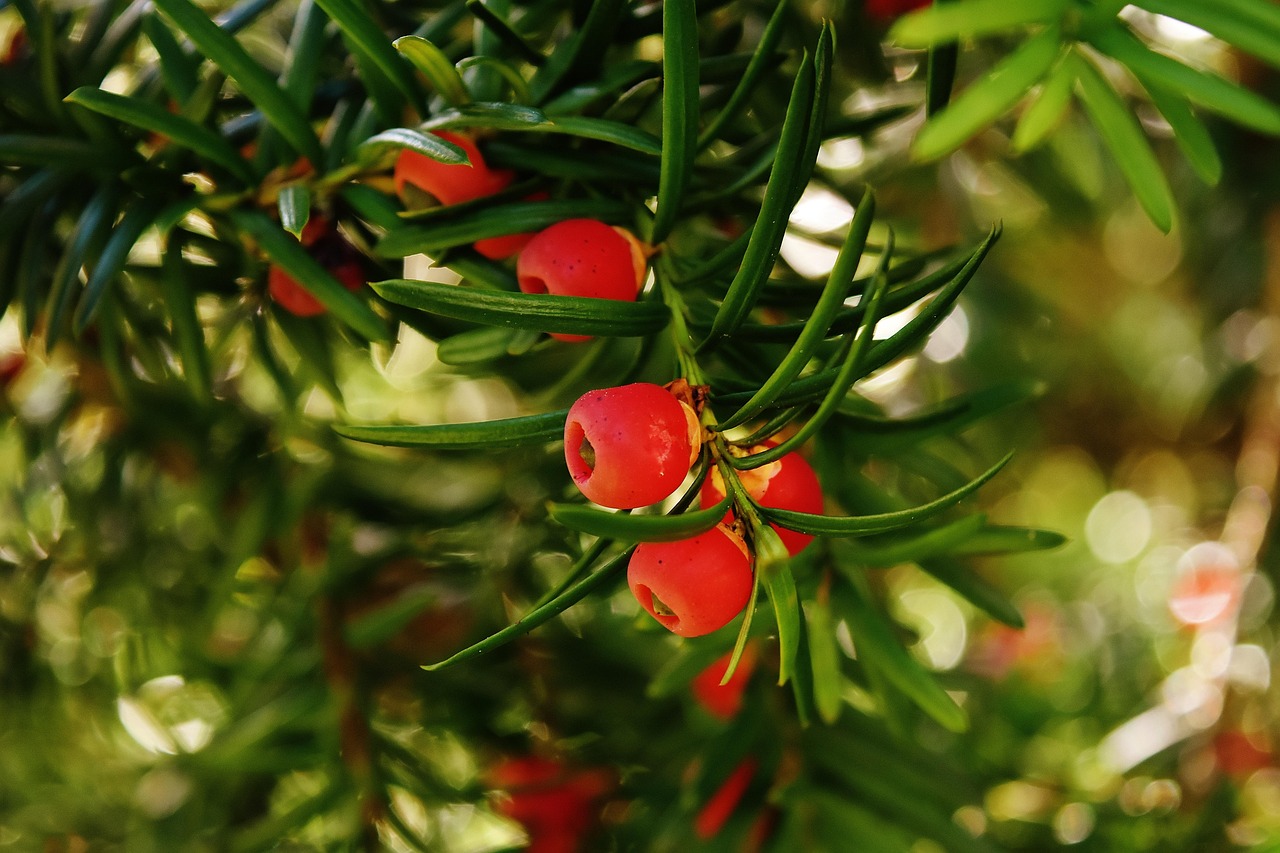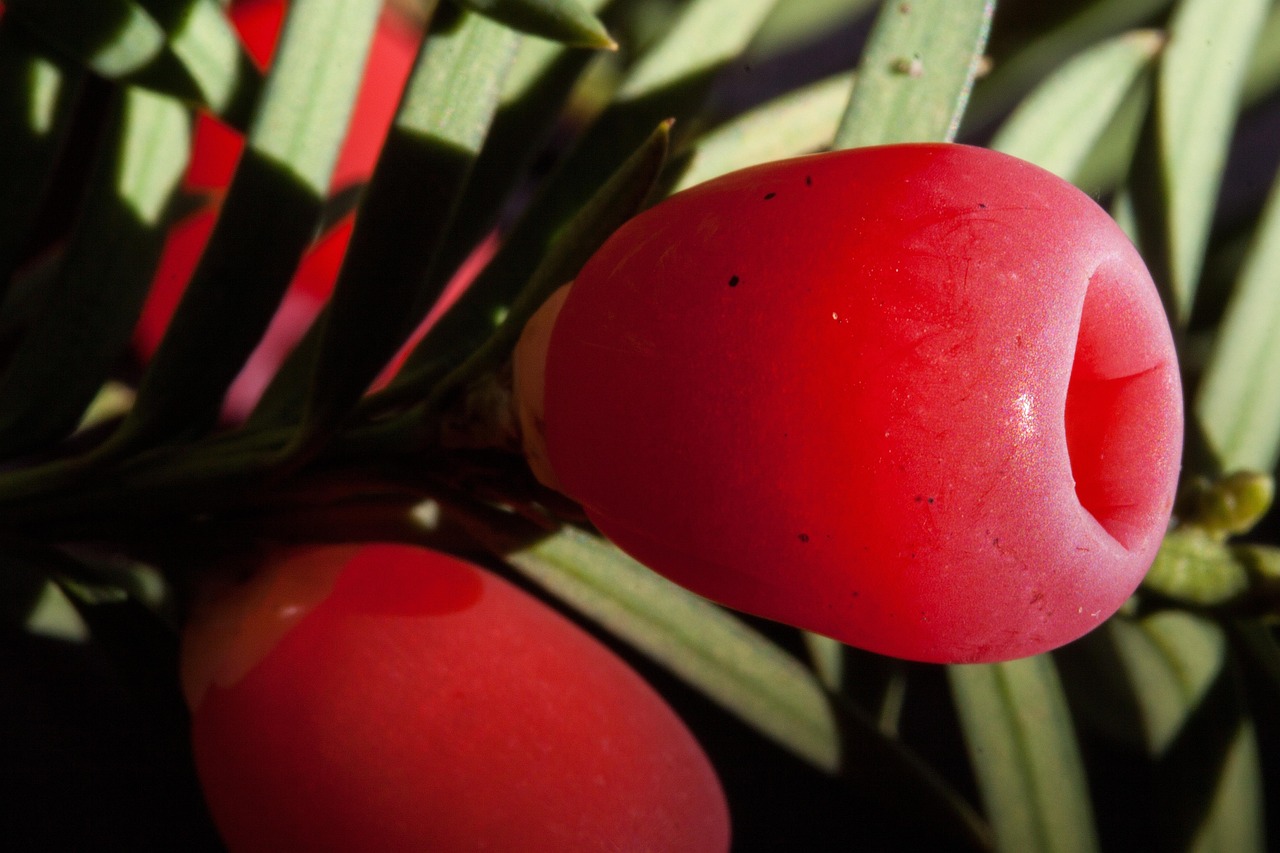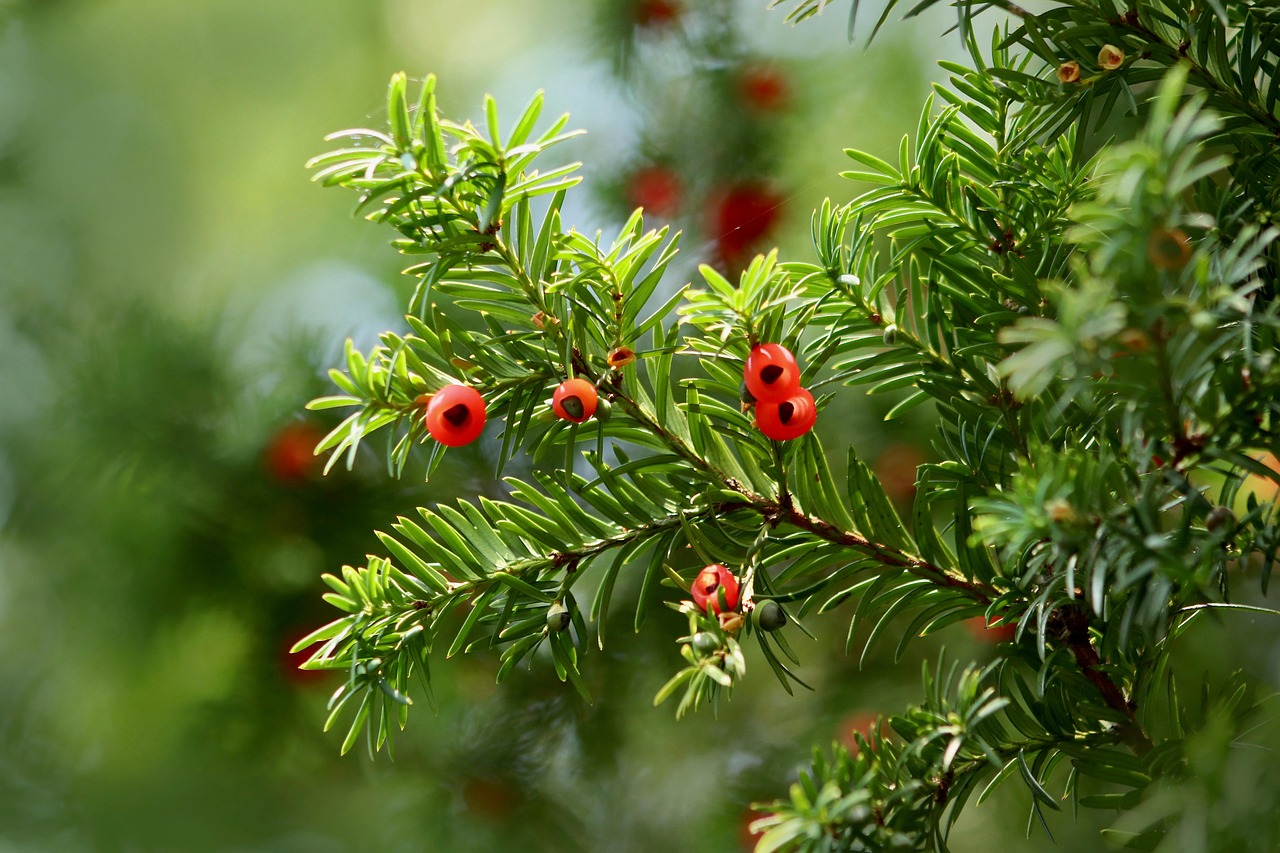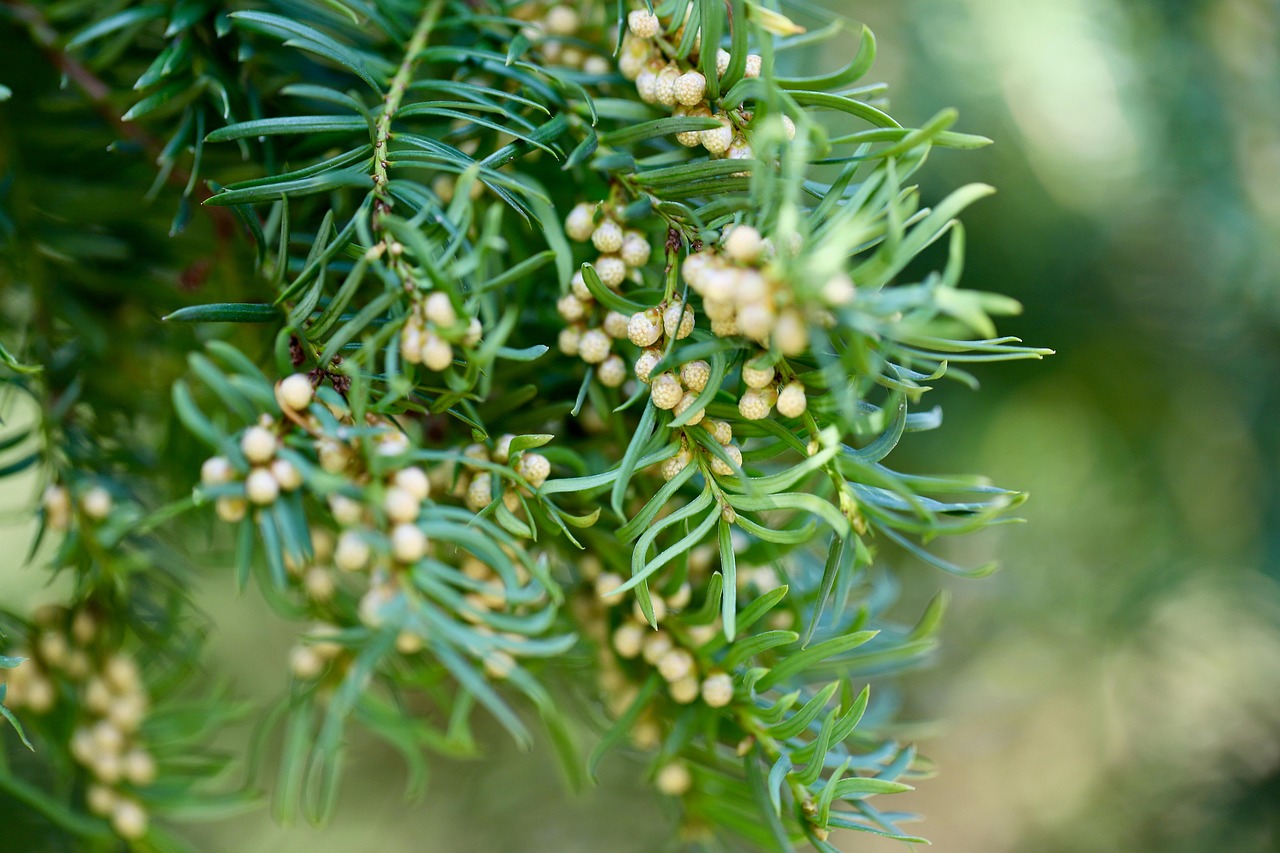Yew Trees: The Timeless Elegance Your Garden Deserves
Yew trees are a stunning addition to any garden. Their rich history and unique characteristics make them a symbol of strength and longevity. With their evergreen foliage and versatile growth habits, yews provide beauty and structure throughout the seasons.
Introduction to Yew Trees
Yew trees, scientifically known as Taxus, belong to the family Taxaceae. These coniferous trees have been admired for centuries, often found in gardens, parks, and churchyards across Europe and Asia. Yews are particularly valued for their ability to thrive in a variety of conditions, making them a popular choice for gardeners.

One of the most appealing aspects of yew trees is their graceful appearance. They possess dark green, needle-like leaves that can create a striking contrast against lighter colors in the garden. Additionally, some yew species can grow into impressive heights, while others remain compact and suitable for smaller spaces.
Yews are also known for their longevity. Some specimens are believed to be over a thousand years old, a testament to their resilience and adaptability. This durability makes them not only beautiful but also a wise investment for anyone looking to enhance their garden.
Types of Yew Trees

There are several species of yew trees, each with distinct characteristics. Understanding these differences can help you choose the right variety for your garden. Below are some common types of yew trees:
- English Yew (Taxus baccata): This species is well-known for its dense foliage and is often used for hedges and topiary.
- Japanese Yew (Taxus cuspidata): A hardier variety that can tolerate colder climates, making it suitable for various regions.
- Western Yew (Taxus brevifolia): Native to North America, this species is smaller and more shrub-like in appearance.
- Chinese Yew (Taxus chinensis): Known for its ornamental value, this yew species has attractive red berries.
Benefits of Planting Yew Trees

Planting yew trees in your garden offers numerous benefits. Below are some key advantages:
| Benefit | Description |
|---|---|
| Evergreen Foliage | Yews maintain their green color year-round, providing continuous beauty. |
| Low Maintenance | Once established, yews require minimal care and can withstand drought. |
| Wildlife Habitat | Yews provide shelter and food for various birds and small mammals. |
| Versatile Design | Yews can be shaped into hedges, topiaries, or left to grow naturally. |
In addition to their aesthetic appeal, yews hold historical significance. They have been used for centuries in landscaping and gardening, often symbolizing death and rebirth in various cultures. This rich background adds depth to their presence in any garden setting.
The timeless elegance of yew trees makes them a cherished choice among gardeners. Their versatility allows them to fit seamlessly into various landscape designs. From formal gardens to natural settings, yews can add structure and beauty while enhancing the overall ambiance of your outdoor space.
Growing Conditions for Yew Trees
Yew trees thrive in various conditions, making them adaptable to different garden environments. However, understanding their specific growing requirements can significantly enhance their health and longevity. Below are essential factors to consider when planting and caring for yew trees.
Soil Requirements
Yews prefer well-drained soil, rich in organic matter. While they can tolerate poor soil conditions, optimal growth occurs in slightly acidic to neutral pH levels. Here are some tips for preparing the soil:
- Drainage: Ensure good drainage to prevent waterlogging, which can lead to root rot.
- Organic Matter: Incorporate compost or well-rotted manure to improve soil fertility and texture.
- pH Testing: Use a soil test kit to determine pH levels and adjust as necessary with sulfur or lime.
Light Requirements
Yew trees are quite versatile when it comes to light exposure. They can grow in full sun as well as partial shade. However, the amount of sunlight can influence their growth and shape:
- Full Sun: Yews in full sun tend to grow denser and develop a more compact form.
- Partial Shade: While yews can survive in shaded areas, they may become leggy and sparse if not given enough light.
Watering Needs
Proper watering is crucial for the establishment and growth of yew trees. Here’s how to manage their watering needs:
- Newly Planted Yews: Water regularly during the first year after planting to encourage deep root development.
- Established Yews: Once established, yews are quite drought-tolerant but still benefit from occasional watering during prolonged dry spells.
Pest and Disease Management
Although yew trees are generally resistant to pests and diseases, they can still be affected by some common issues. Knowing how to identify and manage these problems is essential for maintaining a healthy yew tree.
Common Pests
The following pests can pose a threat to yew trees:
- Spider Mites: These tiny insects can cause needle discoloration. Regularly checking your trees can help catch infestations early.
- Scale Insects: These pests attach themselves to branches and can weaken the tree. Treat with horticultural oils if detected.
Diseases
Diseases that may affect yew trees include:
- Root Rot: This disease can occur in overly wet conditions. Ensure proper drainage to prevent this issue.
- Canker Diseases: Look for dead areas on branches. Pruning affected branches promptly can help limit the spread.
Cultural Significance of Yew Trees
Throughout history, yew trees have held cultural significance in various societies. Their longevity and resilience have made them symbols of immortality and endurance.
Historical Uses
Yews have been utilized for various purposes over the centuries:
- Bows and Arrows: The flexible wood of yew has been prized for making strong bows, particularly in ancient times.
- Cemetery Planting: Yews are often found in graveyards, symbolizing eternal life and remembrance.
Mythology and Folklore
In numerous cultures, yew trees are steeped in mythology:
- Celtic Beliefs: The Celts viewed yews as sacred trees associated with death and rebirth.
- Greek Mythology: Yew trees were linked to Hecate, the goddess of magic and witchcraft.
The rich cultural heritage surrounding yew trees adds an extra layer of appeal for gardeners looking to create a meaningful and beautiful landscape. Incorporating yews into your garden not only enhances its aesthetic value but also connects it to centuries of history and tradition.

Yew Trees in Landscape Design
Incorporating yew trees into landscape design can significantly enhance the overall aesthetic and functionality of outdoor spaces. Their versatility and timeless appeal make them suitable for various garden styles, from traditional to contemporary.
Formal Gardens
Yews are often used in formal gardens due to their ability to be shaped and maintained. Here are some ways to utilize yew trees in a formal garden setting:
- Topiaries: Yews can be pruned into intricate shapes, creating stunning focal points that draw the eye.
- Hedges: Planting yews in a row can form elegant hedges that define garden boundaries or create privacy.
- Garden Rooms: Use yews to create defined spaces within the garden, allowing for separate areas of interest.
Informal Gardens
In informal garden designs, yew trees can provide structure without appearing overly rigid. Here are some ideas:
- Specimen Trees: Allow a single yew tree to grow naturally as a striking feature in a mixed planting scheme.
- Mixed Borders: Combine yews with flowering plants and shrubs for contrast in color and texture.
- Wildlife Gardening: Incorporate yews into a wildlife-friendly garden, providing shelter for birds and small animals.
Caring for Yew Trees Throughout the Seasons
Caring for yew trees involves understanding their seasonal needs. Proper care ensures that they remain healthy and vibrant throughout the year.
Spring Care
As yews emerge from winter dormancy, spring is an excellent time for maintenance:
- Pruning: Early spring is ideal for light pruning to shape the tree and remove any dead or damaged branches.
- Fertilization: Apply a balanced fertilizer to promote healthy growth as new foliage appears.
- Pest Inspection: Check for signs of pests or disease, as early detection can prevent more significant issues later.
Summer Care
During the warmer months, yews require specific attention:
- Watering: Ensure consistent moisture, especially in hot weather. Water deeply to encourage root development.
- Mulching: Apply mulch around the base to retain moisture and suppress weeds.
- Monitoring Growth: Keep an eye on growth patterns to determine if further pruning is necessary.
Autumn Care
As the growing season ends, preparing yews for winter is essential:
- Final Pruning: Late summer or early autumn is a good time for any final shaping before winter dormancy.
- Pest Control: Inspect again for pests as they may seek shelter in the foliage as temperatures drop.
- Watering Adjustments: Reduce watering frequency as rainfall increases and temperatures cool.
winter Care
In winter, yews need protection from harsh conditions:
- Mulch Maintenance: Check that mulch remains intact around the base for insulation against frost.
- Snow Management: Gently brush off heavy snow from branches to prevent breakage.
- Pest Monitoring: Continue to check for pests that may emerge during warmer winter days.
The Aesthetic Value of Yew Trees
The aesthetic appeal of yew trees extends beyond their structure and foliage. Their unique characteristics can enhance the beauty of any garden.
Color and Texture
The dark green needles of yew trees provide a rich contrast against lighter flowers and foliage. Additionally, their bark offers an interesting texture that adds depth to the landscape.
Year-Round Interest
Yews maintain their visual appeal throughout all seasons. In spring, they showcase fresh growth, while in fall, their dark hue contrasts beautifully with autumn colors. Even in winter, their evergreen nature brings life to the dormant landscape.
Personalization and Style
The ability to shape yew trees allows gardeners to personalize their landscapes. Whether you prefer a formal approach with manicured hedges or a more natural look with free-growing specimens, yews can adapt to your design preferences.
This adaptability, combined with their historical significance and cultural symbolism, makes yew trees not only a practical choice but also an enriching element of garden design. The timeless elegance they bring ensures that they remain a cherished component of any outdoor space.
Maintenance Tips for Long-lasting Yew Trees
To ensure that yew trees thrive and maintain their beauty for years, regular maintenance is essential. Here are some practical tips for keeping your yew trees healthy and visually appealing:
- Regular Pruning: Pruning helps maintain the shape of yew trees and encourages bushier growth. Aim to prune them in late winter or early spring before new growth starts.
- Watch for Pests: Regularly inspect your yews for signs of pests or diseases, such as discoloration or wilting foliage. Early intervention can prevent severe infestations.
- Adjust Watering: Consistent watering is crucial, especially during dry spells. However, avoid overwatering as yews prefer well-drained soil.
- Fertilization: Fertilize in early spring using a balanced fertilizer to promote healthy growth. Avoid excessive nitrogen, which can lead to soft, sappy growth that is more susceptible to pests.
- Mulching: Apply a thick layer of organic mulch around the base of the tree to conserve moisture, suppress weeds, and regulate soil temperature.
Yew Trees and Sustainability
In today’s world, sustainability is a significant consideration in gardening and landscaping. Yew trees contribute positively to sustainable practices in several ways:
- Carbon Sequestration: As evergreen trees, yews absorb carbon dioxide from the atmosphere, helping to mitigate climate change.
- Biodiversity: Yews provide habitat and food for various wildlife, including birds and insects, promoting biodiversity in garden ecosystems.
- Longevity: The long lifespan of yew trees means they can be a long-term investment for landscapes, reducing the need for frequent replacements.
Incorporating yews into sustainable gardening practices not only enhances the aesthetic appeal of your garden but also supports environmental health. By choosing native or well-adapted species, gardeners can create thriving ecosystems that benefit both nature and their outdoor spaces.
Cultural Significance and Symbolism
The cultural significance of yew trees cannot be overstated. They have played an essential role in various cultures throughout history. Here are some notable aspects:
- Symbol of Resilience: Yews symbolize resilience and strength due to their ability to thrive in diverse conditions and live for centuries.
- Connection to the Afterlife: In many cultures, yew trees are associated with the afterlife and spiritual realms, often planted in cemeteries to honor those who have passed.
- Traditional Uses: Historically, yews have been used in traditional medicine and for crafting tools, further emphasizing their importance in human culture.
Their deep-rooted symbolism adds a layer of meaning when included in garden designs. Gardeners can create spaces not only for beauty but also for reflection and remembrance.
Final Thoughts
Yew trees truly embody timeless elegance and resilience, making them a cherished choice for gardens worldwide. Their adaptability to various growing conditions allows them to fit seamlessly into multiple landscape styles, whether formal or informal. The ability to shape yews into hedges and topiaries provides opportunities for creativity in garden design.
The combination of aesthetic appeal, ecological benefits, and rich cultural significance makes yew trees more than just ornamental plants; they are living connections to history and nature. For gardeners seeking to enhance their outdoor spaces, incorporating yew trees is a decision that brings both beauty and meaning.
Ultimately, with the right care and consideration, yew trees can thrive for generations, serving as enduring symbols of elegance and strength in your garden. Their presence will continue to enrich the landscape, inviting admiration from all who encounter them.
